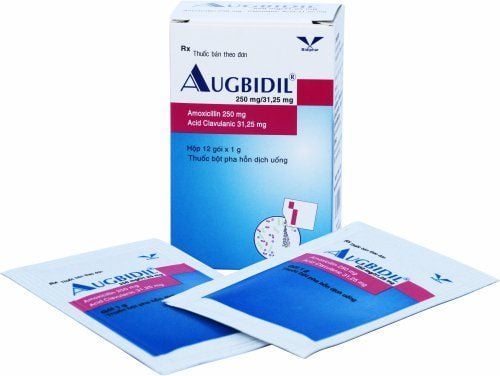This is an automatically translated article.
Bactamox is a combination antibiotic of two active ingredients Amoxicillin and Sulbactam. The drug is indicated in the treatment of bacterial infections such as sinusitis, tonsillitis, otitis media, abscesses, wound infections ... Let's learn about the uses and notes when using Bactamox through the article. write below.
1. Uses of Bactamox 625mg
1.1. Indications Bactamox contains two active ingredients: Amoxicillin - an antibiotic of the Penicillin group and Sulbactam - a Betalactamase inhibitor. The drug is prepared in various strengths as follows:
Bactamox 1g : Prepared in the form of oral tablets containing 875mg Amoxicillin and 125mg Sulbactam; Bactamox 750mg: Prepared in the form of oral tablets containing 500mg Amoxicillin and 250mg Sulbactam; Bactamox medicine 625mg : Prepared as a powder pack containing 500mg Amoxicillin and 125mg Sulbactam; Bactamox medicine 375mg : Prepared as a powder pack containing 250mg of Amoxicillin and 125mg of Sulbactam. Each dosage form and strength will be suitable for each patient's age and infection status. Bactamox is indicated in the treatment of infections caused by sensitive bacteria, including:
Ear - nose - throat infections: tonsillitis, sinusitis, otitis media; Acute and chronic bronchitis, pneumonia ; Urinary-genital infections: urethritis, cystitis, female genital tract infections, urethritis; Abscesses, boils, wound infections; Bone and joint infections; Dental infection: Abscess due to tooth extraction; Other types of infections: Bacteremia in the postpartum period, infections caused by abortion, and intra-abdominal infections. 1.2. Pharmacodynamics Amoxicillin is a semi-synthetic beta-lactam antibiotic with a broad spectrum of bactericidal activity against Gram-negative and Gram-positive bacteria based on inhibition of cell wall synthesis. Amoxicillin is easily destroyed by beta-lactamase enzymes secreted by bacteria, so the drug has no effect on groups of bacteria that secrete this enzyme (especially Haemophilus influenzae, Enterobacteriaceae). The active ingredient Sulbactam is an irreversible competitive inhibitor of beta-lactamase, which enhances the effect of Amoxicillin antibiotics and expands the antibacterial spectrum of the drug to beta-lactamase-producing strains.
The combination of amoxicillin and sulbactam is active against the following bacteria:
Gram-positive bacteria: Streptococcus pneumoniae, Streptococcus faecalis, Streptococcus viridans, Staphylococcus saprophyticus, Streptococcus pyogenes, Staphylococcus epidemidis; Gram-negative bacteria: Escherichia coli, Haemophilus influenzae, Proteus vulgaris, Neisseria gonorrhoeae, Enterobacter species, Moraxella catarrhalis, Acinetobacter; Anaerobic bacteria: Bacteroides group such as Clostridium, B.fragilis, Peptococcus. 1.3. Pharmacokinetics Amoxicillin:
Process of absorption: Amoxicillin is well absorbed from the gastrointestinal tract after oral administration, stable in gastric acid. Food does not affect the absorption of amoxicillin. Peak serum concentrations of Amoxicillin are achieved 1-2 hours after oral administration; Distribution process: Amoxicillin is rapidly distributed into tissues and body fluids (except cerebrospinal fluid, brain tissue), in case of inflammation of the meninges, the drug can diffuse into easily. Approximately 20% of Amoxicillin is bound to serum proteins; Metabolism and Elimination: The half-life of Amoxicillin is about 60 minutes, in children and the elderly the half-life may be longer. Patients with renal failure have a half-life of about 7-20 hours. Of which 60% of the oral dose of Amoxicillin is excreted unchanged in the urine in 6-8 hours. The drug crosses the placenta and is excreted in breast milk in small amounts. Sulbactam:
Process of absorption: The drug is well absorbed from the gastrointestinal tract after oral administration. Peak serum concentrations are reached after approximately 1-2 hours of oral administration; Distribution: Sulbactam diffuses well into body tissues and fluids. Of which, about 40% of the drug dose is bound to plasma proteins; Metabolism and Elimination: Sulbactam is excreted mainly in the urine as unchanged drug, with a half-life of about 1 hour. The half-life is longer in patients with severe renal impairment. Sulbactam crosses the placental barrier and is secreted into breast milk.
2. Dosage of Bactamox 625mg
Bactamox 625mg is taken orally, it can be taken before or after meals. Dissolve the powder in an appropriate amount of cooled boiled water and drink immediately after reconstitution. The dose of Bactamox 625mg used depends on the age and condition of the patient, the recommended dose is as follows:
Adults and children weighing over 40kg: Take 1 pack x 2-3 times/day; Children weighing less than 40kg: In case of mild to moderate infection, the dose is 20mg/kg/day divided into 3 oral doses. In case of severe infection, the dose is 40mg/kg/day divided into 3 doses. The recommended duration of drug therapy is 5 days. Adults with renal impairment: In case of creatinine clearance greater than 30ml/min, no dose adjustment is required. In the case of creatinine clearance between 10 and 30 ml/min, the recommended dose is 250 - 500 mg every 12 hours depending on the severity of the infection. For patients with creatinine clearance less than 10ml/min, the recommended dose is 250-500m/24 hours depending on the degree of infection; Children with renal impairment: In case of creatinine clearance greater than 30ml/min, no dose adjustment is required. In case of creatinine clearance between 10-30ml/min, the recommended dose is 2/3 of the usual dose, divided into 2 oral doses per day. For patients with creatinine clearance less than 10ml/min, the recommended dose is 1/3 of the usual dose, taken once daily.
3. Bactamox 625mg . side effects
Bactamox 625mg drug can cause some side effects as follows:
Common: Skin rash, itching, diarrhea; Uncommon: Vomiting, nausea, rash, eosinophilia, obstructive jaundice, hepatitis, increased transaminases; Rare: Quincke's edema, anaphylaxis, erythema multiforme, Stevens-Johnson syndrome, toxic epidermal necrolysis, exfoliative dermatitis; leukopenia, thrombocytopenia, hemolytic anemia, pseudomembranous colitis, interstitial nephritis. In case of experiencing side effects, the patient should stop using Bactamox and notify the treating doctor for treatment as soon as possible.
4. Notes when using Bactamox 625mg
4.1. Contraindications Contraindicated to use Bactamox 1g, Bactamox 625mg or other doses in the following cases:
People who are sensitive to Amoxicillin, penicillin and cephalosporin antibiotics; People with a history of gastrointestinal disease, especially Cohn's disease, ulcerative colitis or antibiotic-associated colitis; People with a history of jaundice or liver dysfunction. 4.2. Precautions while using Bactamox 625mg Cholestatic jaundice due to Bactamox use can occur, however symptoms usually disappear after about 6 weeks of stopping treatment with the drug. Bactamox 625mg should be used with caution in patients with moderate and severe renal impairment. Serious and potentially fatal hypersensitivity reactions (anaphylaxis) have been reported in patients treated with penicillin antibiotics. There have been reports of erythema multiforme with lymphadenopathy (infectious mononucleosis) in patients receiving amoxicillin. Avoid using Bactamox if you suspect that the patient has infectious mononucleosis. Long-term use of Bactamox increases the risk of developing drug-resistant bacteria. Pregnant women: Studies have shown that taking the drug by mouth does not affect fetal development. However, to ensure safety, the drug should only be used in pregnant women when absolutely necessary and under the direction of a treating doctor. Lactation: Amoxicillin and Sulbactam are likely to be excreted in human milk, therefore caution should be exercised in nursing women.
5. Bactamox 625mg . drug interactions
Bactamox 625 can cause some interactions as follows:
Prolong blood clotting time and bleeding; Bactamox reduces the effectiveness of oral contraceptives, so it is necessary to warn patients about this problem; Probenecid reduces the renal tubular elimination of Bactamox; Nifedipine increases the absorption of the drug Amoxicillin; Amoxicillin reduces the excretion of methotrexate , leading to increased toxicity of the drug on the gastrointestinal tract and on hematopoietic organs; Concomitant use of Bactamox and allopurinol increases the risk of allergic skin reactions; Macrolide antibiotics, chloramphenicol, tetracyclines and sulfonamides can interfere with the bactericidal effect of amoxicillin. Bactamox is a combination antibiotic of two active ingredients Amoxicillin and Sulbactam. The drug is indicated in the treatment of bacterial infections such as sinusitis, tonsillitis, otitis media, abscesses, wound infections... To ensure effective treatment and avoid unwanted side effects , the patient needs to take the drug according to the prescription or consult a doctor or pharmacist.
Follow Vinmec International General Hospital website to get more health, nutrition and beauty information to protect the health of yourself and your loved ones in your family.
Please dial HOTLINE for more information or register for an appointment HERE. Download MyVinmec app to make appointments faster and to manage your bookings easily.













